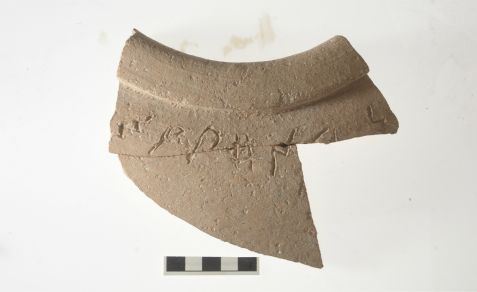
 |
Freethought & Rationalism ArchiveThe archives are read only. |
|
|
#1 |
|
Veteran Member
Join Date: Aug 2004
Location: Orlando
Posts: 2,014
|
 Here is an article from July 10th, 2013, entitled "Oldest Alphabetical Written Text Found Near Temple Mount" It basically states that writing from the Tenth Century B.C.E. Jerusalem was found by the University of Jerusalem archaeologist Dr. Eilat Mazar. This writing is not Hebrew writing. The earliest Hebrew writing found comes from about 725 B.C.E. This writing is 250 years earlier, circa 975 B.C.E. The archaeologist suggested that the writing was "by one of the non-Israeli residents of Jerusalem, perhaps Jebusites, who were part of the city population in the time of Kings David and Solomon." This explanation is problematical for several reasons. Jerusalem was a small city of 1,000-2,000 people at this time. Writing requires a certain infrastructure. You need teachers, schools and scribes for a society to develop writing. With such a small population, it is hard to believe that two different groups developed their own alphabets and writing culture in such a small place. If Hebrew writing existed in Jerusalem at this time and Hebrews were dominant in the society why has no Hebrew writing been preserved or found on any monuments or potsherds. How did the writing of this non-Hebrew culture manage to survive and Hebrew writing fail to survive? We should remember that cities in those days were not the transient multicultural places they are today. Walls were erected to keep foreigners out. You were born in a city, you knew everyone in the city and you dedicated yourself to protecting fellow citizens. The logical evidence from this non-hebrew writing is that another non-hebrew culture thrived in and ruled Jerusalem at this period of time. The earliest Hebrew writing from 725 B.C.E. suggests that Hebrews did not become dominant until this period of time. This seems to me to be the strongest evidence yet to reject the idea of a Hebrew dominated region in the 10th century B.C.E. Warmly, Jay Raskin |
|
|
|
|
#2 |
|
Veteran Member
Join Date: Feb 2012
Location: Auburn ca
Posts: 4,269
|
Jay, the oldest Hebrew writing is from 1000BC on another pottery shard.
Their alphabet was from the Canaanite culture they evolved from. Its not far fetched at all to think a displaced Canaanite scribe settled in with the other Canaanites who settled the highlands of Israel. From 1200 to 1000 BC there was little organization nor city walls to keep people out. Its well known Hebrews did not dominate anything 1000 BC. Only certain theist would debate this, or apologetically inclined scholars who have lost credibility as new work has shown their shortcomings. |
|
|
|
|
#3 |
|
Talk Freethought Staff
Join Date: Apr 2011
Location: Deep South, USA
Posts: 7,568
|
It's difficult to collect enough evidence to prove something never existed.
|
|
|
|
|
#4 |
|
Veteran Member
Join Date: Feb 2012
Location: Auburn ca
Posts: 4,269
|
|
|
|
|
|
#5 | |
|
Veteran Member
Join Date: Aug 2004
Location: Orlando
Posts: 2,014
|
Hi Outhouse,
Then the article is wrong when it places the oldest Hebrew writing at 725 B.C.E.? Do you have a source for this? Warmly, Jay Raskin Quote:
|
|
|
|
|
|
#6 | ||
|
Contributor
Join Date: Jun 2000
Location: Los Angeles area
Posts: 40,549
|
The claim that the oldest example of Hebrew script dates to the 10th c. BCE is based on this.
Quote:
Quote:
|
||
|
|
|
|
#7 |
|
Regular Member
Join Date: Jul 2011
Location: Japan
Posts: 156
|
According to Lemche, the Tel Dan Stele already disproved the existence of King David by showing that bwtdwd originated as a toponym in use around the 8th century.
|
|
|
|
|
#8 | |||
|
Veteran Member
Join Date: Feb 2012
Location: Auburn ca
Posts: 4,269
|
Quote:
Correct Toto. I have no problem placing this as being from proto Israelites who evolved from displaced Canaanites starting around 1200 BC. We know the Hebrew alphabet evolved from the Canaanite alphabet, and with the early Israelite culture being multi cultural. I have no issue as calling this the oldest Hebrew inscription. I also understand Christopher Rollston cautions |
|||
|
|
|
|
#9 |
|
Veteran Member
Join Date: Nov 2011
Location: USA
Posts: 4,095
|
Ah.....the joys of secular religion based on pieces of pottery....
|
|
|
|
|
#10 | |||
|
Veteran Member
Join Date: Aug 2004
Location: Orlando
Posts: 2,014
|
Hi Toto,
Great stuff. Thanks. Thus we now have two different writing systems discovered near Jerusalem from the 10th Century, neither of which resembles the Hebrew of the earliest inscriptions from the 8th century. The city of Khirbet Qeiyafa was apparently even smaller than Jerusalem (1,000-2,000 people) at this time. It had 500-600 people (http://en.wikipedia.org/wiki/Khirbet_Qeiyafa). A writing system is an important part of a culture. This suggests that the culture of the 10th century B.C.E. in this area was vastly different than the culture in the late 8th century B.C.E. Warmly, Jay Raskin Quote:
|
|||
|
|
| Thread Tools | Search this Thread |
|